Roasted Tomatillo Salsa Verde Canning Recipe
This post may contain affiliate links, which means that I may receive a commission if you make a purchase using these links. As an Amazon Associate I earn from qualifying purchases.
Canning roasted tomatillo salsa is a great way to preserve the abundance of tomatillos that the garden produces. Jars of tomatillo salsa verde come in handy for all your favorite Mexican dishes.
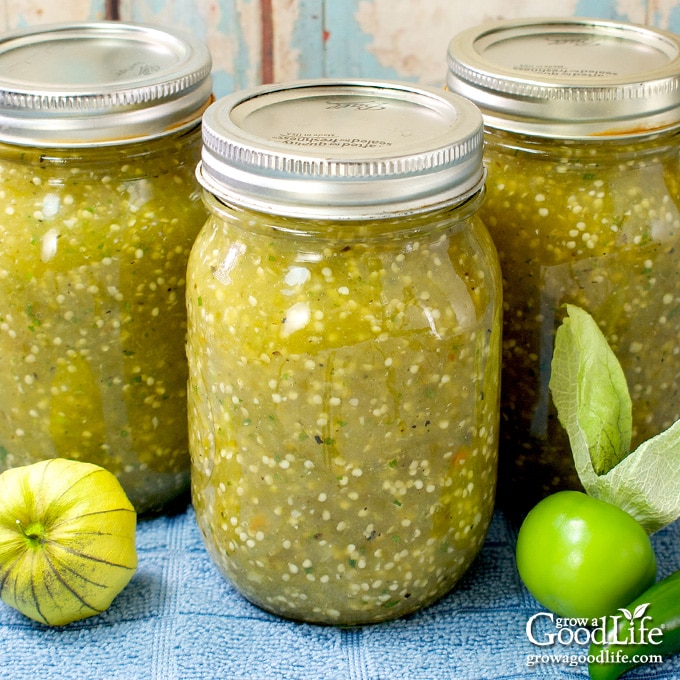
The first time I grew tomatillos in the garden, I thought six plants would be a good number to grow. Ok, ok, I hear the snickers from those of you with experience growing tomatillos.
Tomatillos (Physalis philadelphica), also called husk tomatoes, are native to Mexico and are not very common to our corner of the world, Maine. They are related to the tomato, but grow enclosed in a papery husk.
Tomatillos produce a lot of fruit even when growing in cooler climates, so consider yourself warned if you are thinking of growing some for the first time. Each plant can put out about ten to fifteen pounds.
On a positive note, I had a lot of tomatillos to experiment with. Biting into my first ripe fruit was an unexpected pleasure. I thought it would taste similar to a tomato. Instead, it has a tart and slightly citrus flavor.
The first thing I tried is making with tomatillos was a small batch of salsa verde. It was good! Then I tried roasting it. Roasting the vegetables adds a delicious smoky flavor and mellows the acidity of the tomatillos: Small Batch Roasted Salsa Verde Recipe.
Finding a safe canning recipe for salsa verde that tasted good was challenging. In fact, the recipe I published here previously from the NCHFP website required bottled lemon juice to make it safe for home canning. Many commented that there was too much lemon flavor, and I had to agree.
Finally, I tried a salsa verde recipe from The All New Ball Book of Canning and Preserving that uses fresh lime juice and cilantro. I tested it several times, and it tastes so much better. If you tried the old recipe and were disappointed with the lemon flavor, please give this one a shot.
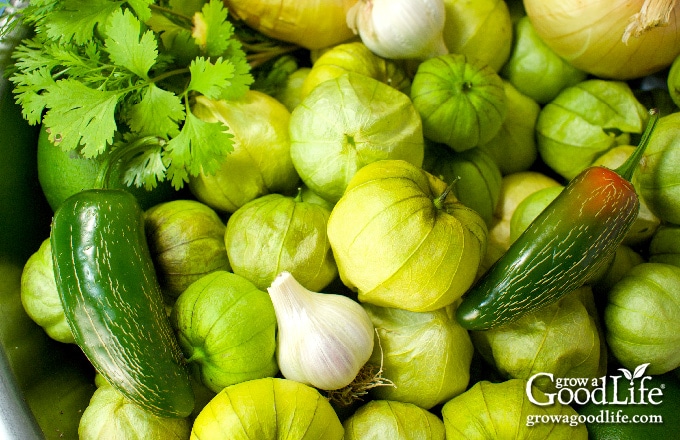
This roasted tomatillo salsa is delicious as a dip with tortilla chips, drizzled on tacos and fajitas. We also like it pouring it over some boneless chicken breasts and cooking in a crockpot to make shredded chicken for salsa verde chicken enchiladas similar to this recipe.
Steps for Canning Roasted Tomatillo Salsa
Tomatillos are easy to preserve into jars of salsa verde. There is no peeling or seeding, simply roast the vegetables, combine the ingredients, blend together, simmer briefly, and process in a water bath canner.
When canning, it is important to follow a recipe that has been scientifically tested. This is the “Roasted Salsa Verde” recipe from The All New Ball Book of Canning and Preserving. It has been doubled for a canner load of 6 pint-sized jars, and the seasonings have been adjusted.
If you are new to canning, it may be helpful to review this article on water bath canning at the National Center for Home Food Preservation website.
A more detailed and printable recipe can be found at the bottom of this article. These are the illustrated steps for making and preserving roasted tomatillo salsa in a water bath canner:
Step 1: Gather the Kitchen Equipment
- 4 rimmed baking sheets or a large roasting pans to roast the vegetables
- Rubber gloves for handling hot peppers
- Food processor to blend the salsa
- Kitchen scale
- Water bath canner and canning rack
- 6 pint sized canning jars
- Canning lids and bands (new lids for each jar, bands can be reused)
- Canning tools: jar lifter, canning ladle, funnel, and bubble popper
- Plus basic kitchen supplies such as a large prep bowl, large saucepan, towels, knife, and a cutting board.
Step 2: Prepare the Vegetables
Peel the husks off the tomatillos and rinse them well to remove the sticky residue. Cut the tomatillos in half and add to the roasting pans. Peel and cut your onions into chunks, wash the jalapeño peppers and add them whole to the roasting pans. Peel your garlic and scatter them over the vegetables.
Roast the vegetables in a preheated oven until everything is softened and charred, about 15-20 minutes. Flip half way through so the vegetables roast evenly. Remove the pan from the oven and let it cool for 5-10 minutes.
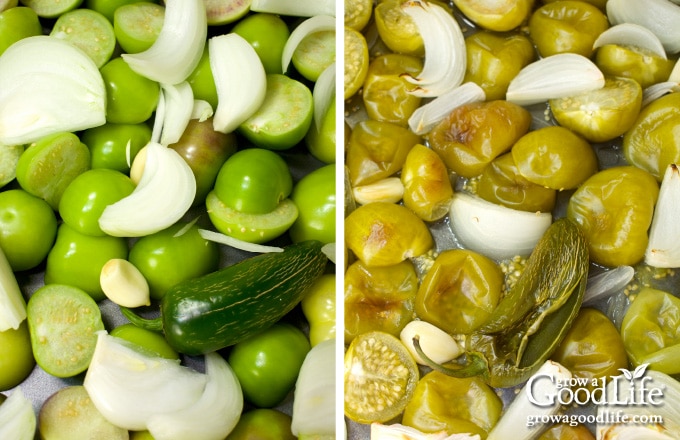
Step 3: Prepare the Canning Jars and Lids
While the vegetables are roasting, prepare the jars, set up the canner, and organize your work area.
Wash your canning jars, lids and bands, and canning tools with warm, soapy water and rinse well. Look the jars over carefully, and eliminate any with chips and cracks. Set lids and bands aside until you are ready to use them.
Place the canner on the stove and insert the canning rack. Set the jars in the canner, add water to cover, and simmer (180˚F) for 10 minutes. Keep hot until you are ready to fill them.
Step 4: Make the Salsa Verde
While wearing gloves, remove stems and seeds from the jalapeño peppers. You can keep the seeds if you like more heat.
Working in batches, add the roasted vegetables and their liquid to a food processor. Process until smooth, and then pour into a large sauce pot. Continue processing the vegetables in batches until done.
Add the lime juice, cilantro leaves, salt, pepper, cumin and stir to combine. Bring the pot to a simmer (180˚F), and then turn the heat to low and keep warm.
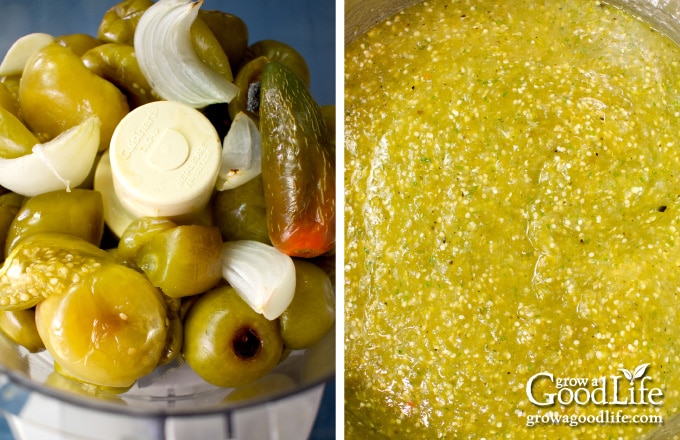
Step 5: Can the Salsa
Spread a dry kitchen towel on the counter. Use the jar lifter to remove a hot jar from the canner, drain, and place on the towel. Keep the remaining jars in the canner, so they stay warm.
Place the canning funnel on the jar, and ladle the hot salsa into the jar while leaving 1/2-inch headspace. Run the bubble popper through the jar to release any trapped air bubbles. Adjust the headspace again if needed.
Wipe the rim with a damp towel to remove residue. Center a lid on the jar, add the band, and screw it on until fingertip tight. Place the jar back into the canner, and repeat with the rest of the jars.
Adjust the water level so it is covering the jars by two-inches, cover the canner, bring it to a boil, and process the jars in a boiling-water canner for the times indicated in the recipe below.
Once processing time is complete, remove the jars, and let them cool undisturbed for 12 to 24 hours. After cooling for at least 12 hours, test the seals. Refrigerate any that did not seal, and use up within a week.
Wash the jars with warm soapy water, dry, label and date the jars, and store in a cool, dark location for 12 to 18 months. Wait several weeks for the salsa to develop its flavor before opening a jar.
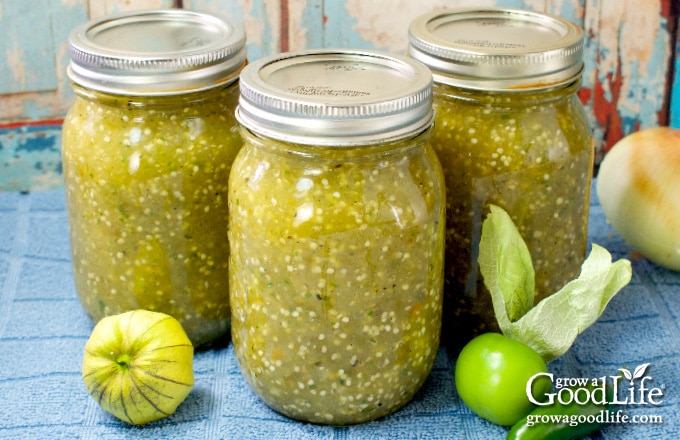
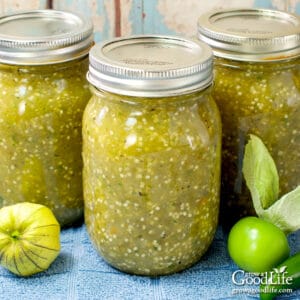
Roasted Tomatillo Salsa Verde Canning Recipe
Ingredients
- 8 pounds tomatillos husks removed
- 4 medium white onions cut into wedges
- 4 jalapeño chiles or serrano peppers
- 6 cloves garlic peeled
- 1 cup fresh lime juice or bottled lime juice
- 1/2 cup chopped fresh cilantro leaves
- 2 teaspoons kosher salt (optional for flavor)
- 1 teaspoon black pepper (optional for flavor)
- 1/2 teaspoon ground cumin (optional for flavor)
Instructions
Prepare the Vegetables:
- Preheat oven to 425˚F.
- Peel the husks off the tomatillos and rinse them well. Cut the tomatillos in half and divide up into the rimmed baking sheets or roasting pans.
- Peel and cut your onions into chunks. Add to the roasting pans.
- Wash the jalapeño peppers and add them whole to the roasting pans.
- Peel your garlic, and scatter into the roasting pans.
- Roast the vegetables in a preheated oven until everything is slightly softened and charred, about 15-20 minutes. Flip half way through so the vegetables roast evenly.
- Remove the baking sheets from the oven and let the roasted vegetables cool for 5-10 minutes.
Prepare your Canning Equipment:
- Wash your jars, lids, screw bands, and canning tools in hot soapy water. Rinse thoroughly to remove all suds. Set aside to air dry on a clean kitchen towel.
- Place the jar rack into water bath canner, place jars in the canner, and add water to cover. Bring the canner to a simmer (180˚F) for 10 minutes, and keep the jars hot until you are ready to fill them.
Make the Tomatillo Salsa Verde:
- While wearing gloves, remove stems and seeds from the jalapeño peppers. You can keep the seeds if you like more heat.
- Working in batches, add the roasted vegetables and their liquid to a food processor. Process until smooth, and then pour into a large sauce pot. Continue processing the vegetables in batches until done.
- Add the lime juice, cilantro leaves, salt, pepper, cumin, and stir to combine. Bring the pot to a simmer (180˚F), and then turn the heat to low and keep warm.
Can the Roasted Tomatillo Salsa Verde:
- Lay a dry kitchen towel on the counter. Use the jar lifter to remove a jar from the canner. Drain the water back into the canner, and place on the towel. Keep the remaining jars in the canner so they stay hot.
- Use the canning funnel and ladle to fill the jar with hot relish, leaving 1/2-inch headspace.
- Wipe the rim to remove any residue, center a lid on the jar, and screw on a band until it is fingertip tight. Use the jar lifter to place the jar back into the canner, and repeat with the remaining jars.
- Once all the jars are in canner, adjust the water level so it is two inches above the jar tops.
- Cover the canner and bring to boil over high heat. Once water boils vigorously, continue boiling for 20 minutes at altitudes of less than 1,000 feet. Adjust processing time for your altitude if necessary (See Notes).
- When processing time is complete, turn off the heat, and let the canner cool down and settle for about 5 minutes.
- Spread a dry kitchen towel on the counter. Remove the cover by tilting lid away from you so that steam does not burn your face.
- Use the jar lifter to remove the jars from canner and place on the towel. Keep the jars upright, and don't tighten bands or check the seals yet. Let sit undisturbed for 12 to 24-hours to cool.
- After 12 to 24-hours, check to be sure jar lids have sealed by pushing on the center of the lid. The lid should not pop up. If the lid flexes up and down, it did not seal. Refrigerate jar and use up within a week.
- Remove the screw on bands and wash the jars. Label, date, and store in a cool, dark place for 12 to 18 months. Allow at least 3 to 4 weeks for the salsa to develop its flavor. Once the jar is open, refrigerate and use up within a week. Yields about 6 pints.
Notes
Nutrition
This recipe was originally published July 29, 2018. It has been updated with new photos, more detailed information, and a much better tasting safe canning recipe.
You May Also Like:
- Zesty Salsa Recipe for Canning
- How to Can Tomatoes
- Seasoned Tomato Sauce Canning Recipe
- How to Can Poultry Meat
If you love salsa, consider adding our eBook, Grow a Good Life Guide to 50 Salsa Canning Recipes, to your resource library. This 72-page eBook is packed with a variety of delicious salsa recipes, including classic tomato salsas to roasted and grilled salsas to tomatillo and delicious fruit blends, all safe for water bath canning. It’s the perfect guide to help you preserve your garden harvests.

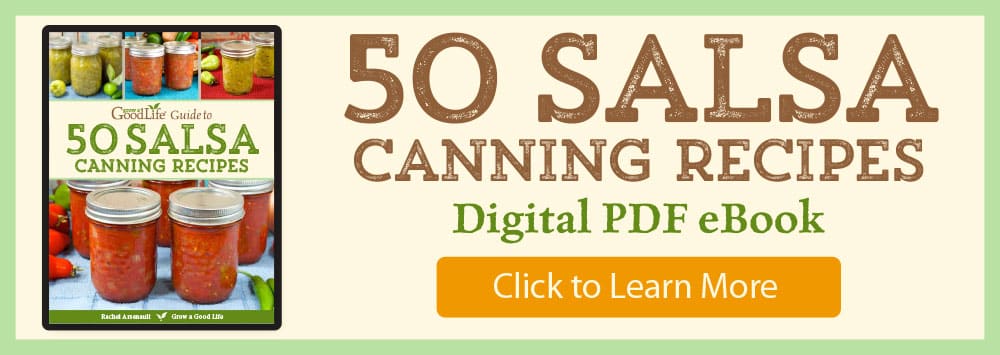
Hi, thanks for sharing the recipe! Can vinegar be substituted for the lime juice? Thanks!
Martha
Martha, Unfortunately, vinegar cannot be substituted for lime juice in this recipe. Lime juice is necessary to maintain the correct acidity level for safe canning. Substituting with vinegar could result in a less acidic salsa, which might not be safe for shelf storage.
Hello,
I’m going to try this recipe today. I have a couple questions as I’ve never made verde salsa before. Some of my tomatillos are a white color and white/purple color. Is it ok to mix them in with the others? Also, I’m a bit confused about the cilantro. In the photo I don’t see chunks of cilantro is this supposed to be cooked down and then put in blender or food processor before adding to jars?
Won’t the taste get cooked out or be yucky and wilted looking?
Hello Jenn! Yes, it is perfectly fine to mix all your tomatillos, even if they are white or white/purple in color. They will blend in just fine with the others. As for the chopped cilantro, it’s added in step 3 under Make the Tomatillo Salsa Verde in the recipe card: “Add the lime juice, cilantro leaves, salt, pepper, cumin, and stir to combine.”
Great thank you!
So for cilantro you will see more chunky pieces? Thats what I was wondering since the photo of salad you can’t see any cilantro. Do you make it super small pieces?
Jenn, Yes, there is cilantro in the photo, though it’s not very noticeable because it blends in with the other ingredients. As for the size of the cilantro pieces, that’s up to you! The recipe calls for up to 1/2 cup of chopped fresh cilantro leaves, so if you prefer smaller pieces, you can blend the cilantro with the roasted vegetables. You can also adjust the amount or even skip the cilantro altogether if it’s not to your taste.
can I make my salsa chunky instead of blending it smooth?
Angela, This recipe is specifically designed for a blended tomatillo salsa to ensure even heat distribution during canning. If you prefer a chunky salsa, I recommend trying the Tomatillo Green Salsa recipe from the NCHFP website, which is safe for canning and designed for a chunkier texture.
I would like to pressure.Canvas as to water bath.How long would I process for ?
Thank you for your time and consideration on my question.
Debi, This salsa recipe is specifically developed for water bath canning and has not been tested for pressure canning. Since canning recipes are carefully tested for safety, including the method and processing times, it’s important to follow the recommended technique to ensure a safe product. I would recommend sticking with the water bath method for this salsa.
Can I make this over 2 days? for example today all the veggies and food processor them one day and thenheat to 180F and can it the next?
Lisa, Yes, you can definitely split the process over two days! Preparing the veggies and processing them in the food processor one day, then heating the jars and salsa mixture to 180°F, and canning it the next day is a great approach. Just make sure to refrigerate the prepared mixture overnight to keep it fresh before proceeding with the canning process.
hi I made this today and ended up with about 9.5 pints instead of the 6. is this ok?
Matt, It’s great to hear that you made the recipe. The yield can sometimes vary due to differences in produce size, water content, and roasting time. If you followed the recipe, including weighing and measuring the ingredients, roasting the vegetables until soft, and then pureeing them, your jars should be safe. Enjoy your salsa!
My salsa Verde separated after canning. Do you think it’s still okay?
Leslie, It’s not uncommon for homemade salsa verde to separate slightly after canning, and it’s safe as long as you followed the recipe. When you open the jar, just give it a good stir to mix everything back together, and it should be perfectly fine to enjoy.
Can I substitute lime with lemon?
Rodrigo, Yes, you can.
Oh my goodness! This is the best tomatillo salsa recipe EVER!! I never leave comments or take the time but this deserved a little love! THANK YOU!! I live for a great salsa recipe and you nailed it! So YUM!!
Hi, I want to do a mix of roasted tomatoes and tomatillos. How do I adjust the recipe for the added tomatoes? Is it safe?
Joan J, Mixing roasted tomatoes and tomatillos sounds like a delicious idea! However, when it comes to canning, it’s essential to follow a safe tested recipe to ensure the safety and quality of your preserved product. Adjusting canning recipes can affect the acidity and processing times, potentially compromising safety. I recommend checking out the ‘Roasted Tomato Chipotle Salsa‘ recipe on the Ball website. It’s a tested and safe canning recipe that incorporates both ingredients.
Can you swap the jalepeno peppers for poblanos?
Candace, Yes, you can swap out the peppers for an equal amount of another variety.
I just made this today. Added a tablespoon of sugar to the mix. Boiled the mixture for 2 minutes and water bathed the jars for 20 minutes. Very tastey.
I am wondering it says 4 medium onions. Does the canning book give the grams? Or ounces? Thanks!
Debra, The Ball recipe calls for 4 medium onions, rather than a specific weight or volume measurement, which means they have accounted for some variation. However, a medium onion typically averages around 6 to 8 ounces (170 to 227 grams).